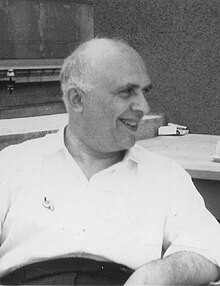
Vitaly Halberstadt (20 March 1903, Odessa – 25 October 1967, Paris) was a French chess player, theorist, problemist, and a noted endgame study composer.[1]
Born in Odessa, in the Kherson Governorate of the Russian Empire (present-day Ukraine), he emigrated to France after the Russian Civil War.
Chess games
[edit]
| Year | Placement | Competition or location | Victor of year |
|---|---|---|---|
| 1925 | 1st place (shared with Abraham Baratz) | Paris City Chess Championship | Halberstadt and Baratz |
| 1926 | 2nd place | Leon Schwartzmann | |
| 5-6th places | Hyères | Abraham Baratz | |
| 1st place (shared with Peter Potemkine) | Paris | Halberstadt and Potemkine | |
| 1927 | 5-7th places | Paris City Chess Championship | Abraham Baratz |
| 1928 | 10-11th places | ||
| 1st-3rd places (tied with Marcel Duchamp and J.J. O'Hanlon) | Hyères | Halberstadt, Duchamp and O'Hanlon | |
| 1930 | 8th place | Paris City Chess Championship | Josef Cukierman |
| 1931 | 6th place | Eugene Znosko-Borovsky | |
| 1932 | 3rd place | Oscar Blum | |
| 1938 | 9th | Paris (L'Echiquier) | Baldur Hoenlinger |
Publications
[edit]In 1932, Halberstadt published with Marcel Duchamp "L'Opposition et les cases conjugées sont réconciliées", a chess manual dedicated to several special end-game problems, for which Duchamp designed the layout and cover.[3] In this book, Duchamp and Halberstadt addressed the complication of the so-called "heterodox opposition", which is a precisely organized endgame that involved two kings and a handful of pawns.[4] This concept has established a figure of immobilized reversibility between two subjective positions and two players.[4] Within a condition where only two kings remain,[5] the duo described the move in the following manner:
The king 'may act in such a way as to suggest he has completely lost interest in winning the game. Then the other king, if he is a true sovereign, can give the appearance of being even less interested.' Until one of them provokes the other into a blunder.[6]
Halberstadt was also the author of "Curiosités tactiques des finales" (1954).
References
[edit]- ^ "Halberstadt". heritageechecsfra.free.fr.
- ^ "Amsterdam (NED-ch10th) 1938". Archived from the original on 2010-12-15. Retrieved 2010-12-15.
- ^ Art, Philadelphia Museum of. "Philadelphia Museum of Art - Archives : Finding Aids". www.philamuseum.org.
- ^ a b Joselit, David (2001). Infinite Regress: Marcel Duchamp, 1910-1941. Cambridge: MIT Press. p. 174. ISBN 9780262600385.
- ^ Witham, Larry (2013). Picasso and the Chess Player: Pablo Picasso, Marcel Duchamp, and the Battle for the Soul of Modern Art. Hanover: UPNE. p. 327. ISBN 9781611682533.
- ^ McEvilley, Thomas (1999). Sculpture in the Age of Doubt. New York: Allworth Press. pp. 56. ISBN 1581150237.
External links
[edit]- Vitaly Halberstadt player profile and games at Chessgames.com
Well, that’s interesting to know that Psilotum nudum are known as whisk ferns. Psilotum nudum is the commoner species of the two. While the P. flaccidum is a rare species and is found in the tropical islands. Both the species are usually epiphytic in habit and grow upon tree ferns. These species may also be terrestrial and grow in humus or in the crevices of the rocks.
View the detailed Guide of Psilotum nudum: Detailed Study Of Psilotum Nudum (Whisk Fern), Classification, Anatomy, Reproduction